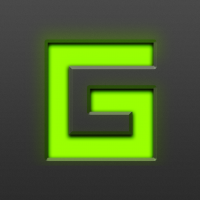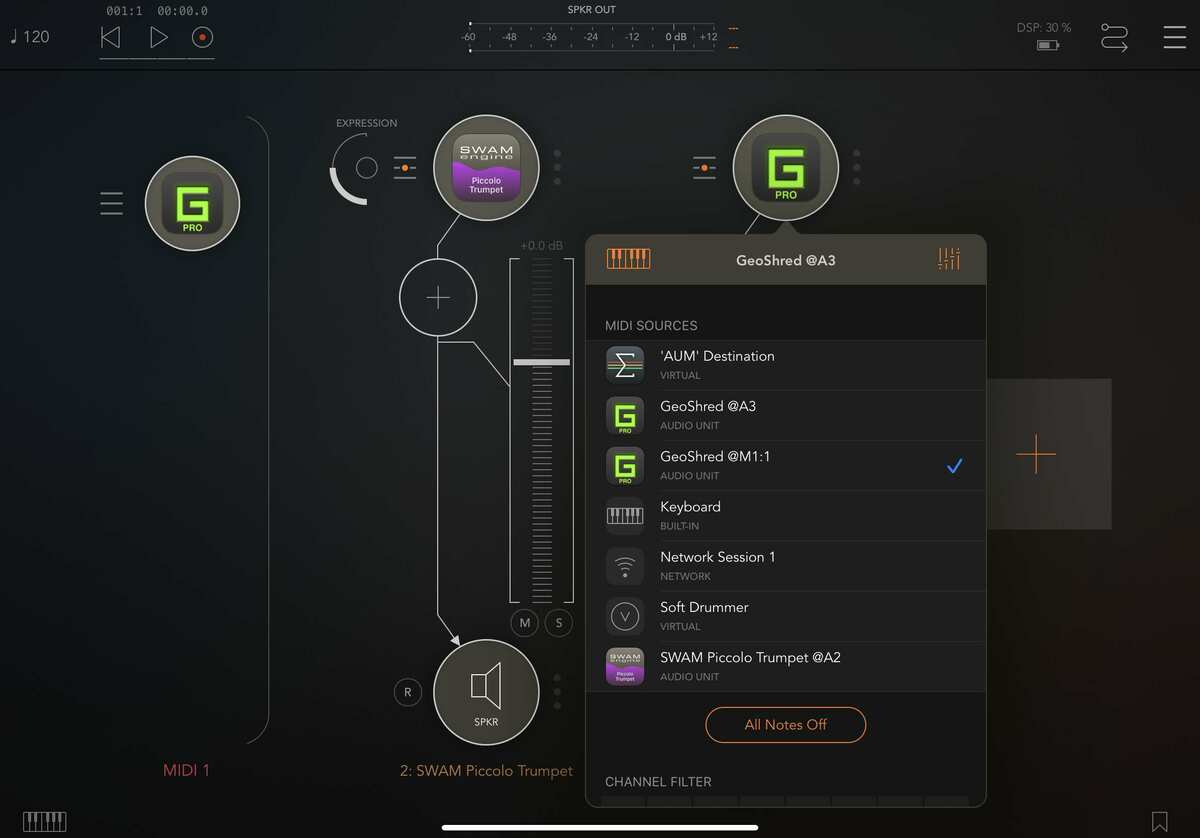Loopy Pro: Create music, your way.
What is Loopy Pro? — Loopy Pro is a powerful, flexible, and intuitive live looper, sampler, clip launcher and DAW for iPhone and iPad. At its core, it allows you to record and layer sounds in real-time to create complex musical arrangements. But it doesn’t stop there—Loopy Pro offers advanced tools to customize your workflow, build dynamic performance setups, and create a seamless connection between instruments, effects, and external gear.
Use it for live looping, sequencing, arranging, mixing, and much more. Whether you're a live performer, a producer, or just experimenting with sound, Loopy Pro helps you take control of your creative process.
Download on the App StoreLoopy Pro is your all-in-one musical toolkit. Try it for free today.
GeoShred Questions
There have been quite a few questions about GeoShred in the AudioBus forum. We are starting a topic to consolidate questions. As a starting point, we have an FAQ about where to find help resources for GeoShred.
http://www.moforte.com/geoShredAssets5.0/help/FAQs/#help
Thanks and we look forward to learning about how folks are using GeoShred.



Comments
How to add a volume control to finger expression?
How to use finger expression for a volume swell is covered in this application note:
I’ve been exploring the sound design stuff a bit lately and have trouble with things quickly going from ‘getting interesting’ to ‘uncontrollably distorted’ when adding elements or spelling in ‘more’ to properties of the sound generation.
Also, I’m probably asking for the impossible, but I can’t find a way to get a slow attack...
Physical Models don't have ADSRs like classical analog synths because the sound evolves forward over time from the physics.
You can however have a swell with the three classes of models in GeoShred,
The GeoShred Plucked String model, is excited impulsively, so the physics does not cover a slow attack except with a swell (look at presets like "#3 Fripper Finger Swell" (mono), or "#25 Howe Classic" (mono) or "#139 Shred MPE Swell" (polyphonic on a per string basis. The swells are on KeyY.
The GeoSWAM Bowed String models. Slow attacks can be achieved with the expression control which is on KeyY.
The GeoSWAM Woodwind models, slow attacks can be achieved with the expression control which is KeyY.
Video examples here:

The video manual for GeoShred has an extensive overview of the plucked string physical model:

@Krupa load it into drambo and use an env
Cheers @moForte I’ll look at those presets for some inspiration, I’ve mostly been making myself explore the guitar model as I already love the SWAM ones but I’ll have a delve into them as well... I’ve been reading the manual on the guitar model which is nicely complete and succinct, but I’m wondering of you had or know any good strategy guides to sound design with it?
Also, cheers @shinyisshiny I did try some envelope following stuff which works to an extent but the guitar model is polyphonic so the envelope ends up triggered when you arpeggiate more notes...
One other thing that I’ve just been stumped by is whether there’sa way to set x motions on the keys to affect parameters - I just thought it would be interesting to try formants morphing with slides on one of the woodwinds, but there’s only the choice of y or z...
I usually have the opposite problem—the attack is too slow to allow rapid shredding. The swams in particular suffer from this.
You can assign KeyX to control parameters in the guitar and effects, but not in the GeoSWAM instruments. It's done in a way that is not canonical with PolyExpr. We may change that in GeoShred 6 (about a year away) Here is a video showing how:
Are the formant filters in the geoswams native to swam, or could they also be used in regular geoshred patches?
The GeoSWAM woodwinds have a formant filter. It's very subtle and it's built into the model. In the effects library for GeoShred there are a number of powerful filters: A 4band PEQ, an Octave Band EQ, and a full circuit model of the Moog VCF. Any of these filters can be placed inline in the audio processing chain after a GeoSWAM instrument, and can be controlled with all the usual GeoShred Control mechanisms, Key[X|Y|Z], control surface controls.
Oh nice, that's really simple, thanks! I'll keep my eyes peeled and fingers ready for v6 as well, cheers
I was actually thinking of the geocello vowel patch. Is that one built into the model too?
That is a good question. It's NOT built into the GeoCello. That is a fun bit of engineering that we did using the 4 band PEQ and publicly available data about vocal track vowel formants, GeoShred's multi parameter lookup tables (aka "curves") and GeoShred's control mechanisms. I'll do an Application Note video about this later today.
Very cool. That’s a great patch.
Different question: It should be possible to use GeoShred to control swam trumpet while simultaneously playing a GeoShred patch, right? So as to layer the two sounds under a single performance? I’d love to have some Nasty Boy-style feedback swell up underneath the trumpet model.
Is there any way to flip the top bar on the UI? I’m left handed and would find it easier to control parameters with my right hand without having to crisscross
@Wrlds2ndBstGeoshredr I found that, using Cubasis, I can create a SWAM trumpet channel, a Geoshred channel, arm them both and open Geoshred in standalone with midi out selected. I guess AUM you could create two audio channels and open Geoshred in a midi channel and select them both to have Geoshred feed them?
Is this what you’re looking for? Hope it helps if so.
Tnx for sharing that. I thought it might be possible. I can imagine several ways of doing it, but have little confidence in my midi wrangling skills. I bought the trumpet last night and only managed to get GS to control it by referring to the video tutorial, but I doubt I could have done it on my own.
@Wrlds2ndBstGeoshredr may I ask what DAW you are using? I also have the trumpet and am learning new midi tricks each day...
I haven’t tried it in Cubasis yet. I had swam trumpet loaded in AUM. It responded to GS, but I actually didn’t have GS loaded into anything at all.
I only just got trumpet last night. I’ll see if I can get any further with the midi tonight, but I tend to get distracted by jamming.
@Wrlds2ndBstGeoshredr my favourite part of being in a band was jamming. Gigs were good but jamming and losing yourself is the business. If you record anything in Cubasis and need any tips then I’m happy to share what I’m learning. Have fun with your trumpet, I know I am 😁
Was just chattering on about this yesterday on the forum here ... I've got he same question. Not because of any sinister left-handedness but I am a long-time string player violins and cellos mostly ... and all the expression comes from my bow hand and arm ... so instinctively I end up playing geoshred blind with my right hand up on the x/y pad and my left doing god knows what underneath in the dark.
In short, is here any way to move the control surface elements around on the screen. I've read yer excellent manuals above but I can't find anything about moving the controls in the editor. Something for Geoshred 6 perhaps?
A resized nice long strip down the right hand side of the screen would be lovely thanks ... almost as good as a 3D ... and some sort of attack/friction/ velocity settings that mimic a bow ... bliss on a stick! Some custom expression sets for woodwinds and brass miht be interesting too. IAPs?
Wonderful instruments you're making. But it just makes us hungry for more.
@Wrlds2ndBstGeoshredr , there are many ways of connecting GS to SWAM or indeed any other sound source including GS itself i.e. Source and Target loaded outside of AUM. Source outside and Target inside AUM and finally both in AUM. All work and have pros and cons. The most flexible I think is have all in AUM. For this I would load a MIDI instance of GS in AUM. Then an Audio instance of the sounds I want , including GS. Then just select the MIDI GS as the source for each sound and make sure the midi setting in the MIDI GS is MPE Channel Mode. See attached screenshot.

@Soundscaper , you can move some control elements but unfortunately not Octave, Expression x/y and the Preset selector. Not left handed but can see why this could be an issue.
Tnx very much. I will give it a try.
How can I set the screen in GS to match the highest and lowest notes in the SWAM instrument I’m controlling? I don’t want to see the out of range notes on my GS screen. I would like to blank them out as in the GeoSWAM instruments.
I’m getting dropouts in my GS-to-SWAM midi connections. I’m using IAA instances of both, and in AUM. It’s most noticeable with the bass tuba. I can be sustaining a note, and it sounds like it’s stuttering due to the midi connection going intermittent. I had similar problems with trumpet, but tuba is much worse. Setup is as in the App Notes video.
Also, the GS SWAM controller patch zeros out the bass tuba’s volume at the bottom of the GS expression range. How to raise the volume floor?
@Wrlds2ndBstGeoshredr , re highest / lowest notes... you can’t . I raised this with Pat from MoForte a week or two ago and you can’t at the moment. It is a special feature of the GeoXXX instruments but you can’t do it with SWAM. perhaps they can build it into V6?
re stuttering, I will try Bass Tuba as I don’t think I have tried it yet and report back (tomorrow)
@Wrlds2ndBstGeoshredr , tried the Bass Tuba this morning and it was fine for me. Happy to try and help if you are still having issues / have more info.
Not really questions but a video showing some features in GS that people might not be aware of i.e...

GS has an inbuilt looper that is less than obviously called Trail Blazer Echo. It has taken me a while to figure out how to use it but video shows it in use.
Also the normal '2nd Hrmnic' button can be replaced by a stepper control that gives access to 2nd, 3rd, 4th etc. harmonics.
Whole thing is going through Flux Mini which I think is a great little app.
Very nice demo; tnx.